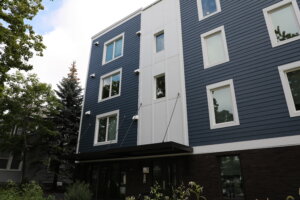By Amanda Theisen
Cody Fischer started Footprint Development five years ago, combining his passions for urbanism and climate change by building low-carbon, neighborhood-scale apartments.
 “The built environment impacts quality of life, social mobility and economic inclusion,” Fischer says. “I’m fascinated by what makes cities work — and it’s not just density. Living in places like London, Chicago and Washington, D.C., I spent time observing the difference between vibrant neighborhoods, and dense but dead ones. The places I love have a mix of uses. People live within walking or biking distance of their favorite shops, parks, restaurants and other amenities. And they can easily take public transit to get to other parts of the city.”
“The built environment impacts quality of life, social mobility and economic inclusion,” Fischer says. “I’m fascinated by what makes cities work — and it’s not just density. Living in places like London, Chicago and Washington, D.C., I spent time observing the difference between vibrant neighborhoods, and dense but dead ones. The places I love have a mix of uses. People live within walking or biking distance of their favorite shops, parks, restaurants and other amenities. And they can easily take public transit to get to other parts of the city.”
“There’s a certain dynamism that comes with fine-grain urbanism,” Fischer adds. “That is why the projects I do are neighborhood projects that enhance our urban fabric.”
Fischer’s work is also motivated by the climate crisis.
“What, how and where we build has a huge impact on climate change,” he says. “New construction and building operations account for over 40% of greenhouse gas emissions. Transportation is our #1 source of emissions in Minneasota. Housing developments today aren’t climate-compatible, so we must change how and what we build.”
That is why Footprint Development is carving out a niche building energy efficient, low carbon housing projects in existing, dense, urban neighborhoods.
Passive House Standards
 One of Fischer’s most high-profile developments in Minneapolis is Solstice Northeast, a 23-unit building located on Van Buren St. NE. It is the first market-rate Passive House-certified apartment building in Minnesota. Passive House is the most rigorous standard for energy efficiency. The end result is an ultra-quiet, comfortable, healthy building that is up to 70% more energy efficient than a typical new building.
One of Fischer’s most high-profile developments in Minneapolis is Solstice Northeast, a 23-unit building located on Van Buren St. NE. It is the first market-rate Passive House-certified apartment building in Minnesota. Passive House is the most rigorous standard for energy efficiency. The end result is an ultra-quiet, comfortable, healthy building that is up to 70% more energy efficient than a typical new building.
Solstice is also low-embodied carbon. Embodied carbon is the term for emissions that come from manufacturing and installing construction materials. According to Fischer, nearly 80% of a new building’s emissions in its first 10 years come from embodied carbon.
“Carbon-smart, climate-compatible buildings are low embodied carbon buildings,” says Fischer.
Units at Solstice have triple pane windows, all-electric appliances, highly insulated walls and continuously HEPA filtered air.
Solstice received its Passive House certification in 2024 and opened this past March. As of September, all but one of the building’s 23 units were occupied. Up next, Fischer is working on a new 32-unit complex along Minnehaha Avenue. Sunrise Banks provided net zero construction loans for both projects.
Overcoming Challenges
Fischer has overcome several challenges during the building process. This includes opposition from neighbors, legal issues, even a temporary injunction of the Minneapolis 2040 plan. But he says he’ll continue to advocate for these types of sustainable housing projects in the City, and he’s glad to have a partner like Sunrise Banks.
“The Sunrise team was really in my corner from day one. Underwriting for projects like this is a bit different, and they were tireless figuring out how to get to ‘yes’,” Fischer says. “They’re willing to be creative and invest in impact.”
Learn more about Net Zero Financing at Sunrise Banks for commercial projects that reduce or avoid carbon emissions at sunrisebanks.com/net-nezo-financing.
Sunrise Banks is an Equal Housing Lender. Member FDIC.
Amanda Theisen is the communications manager at Sunrise Banks.
This article originally appeared in Twin Cities Business Magazine.


